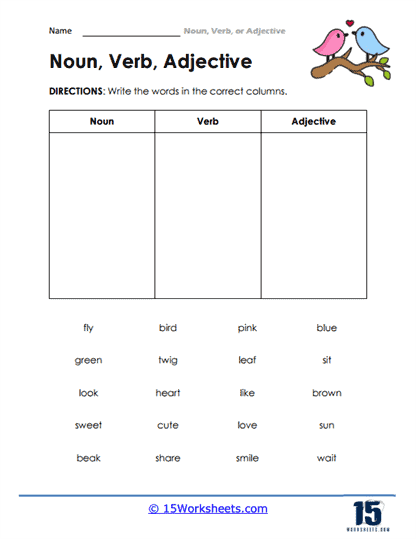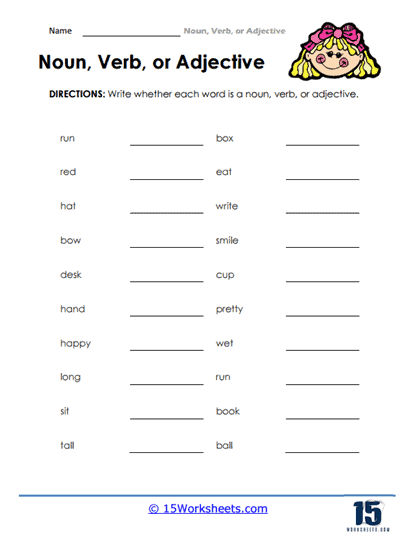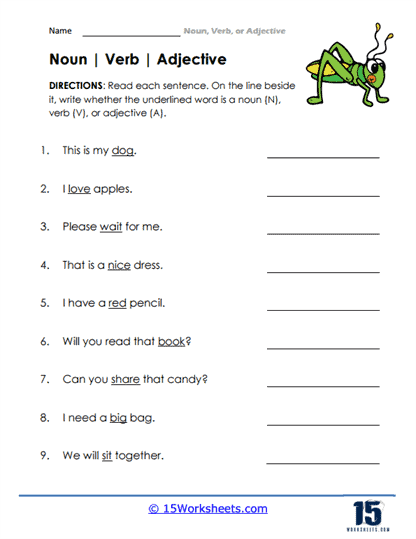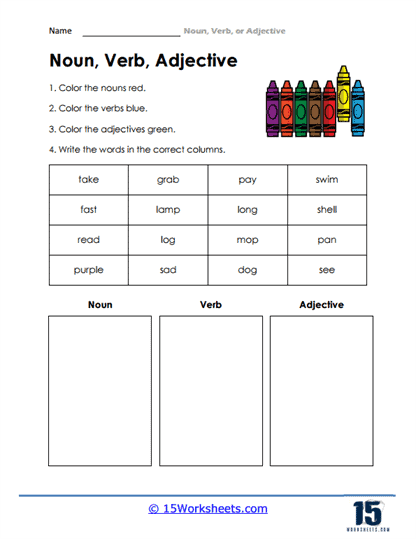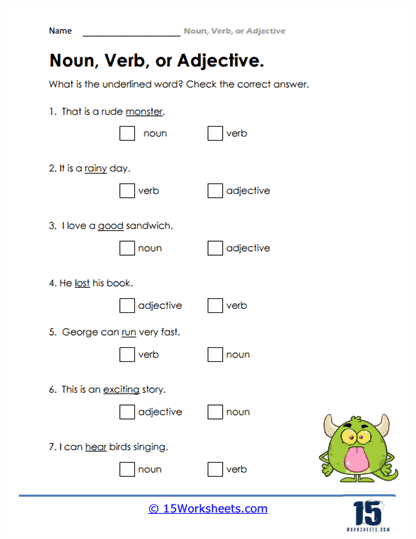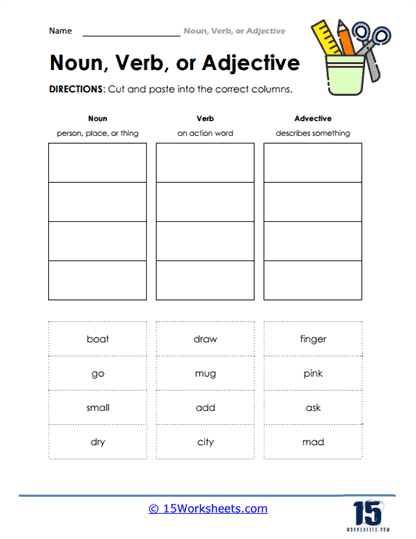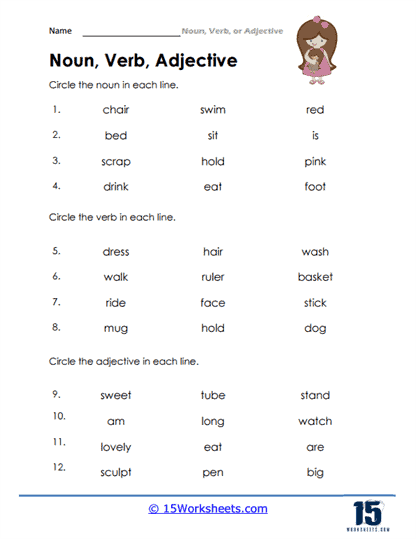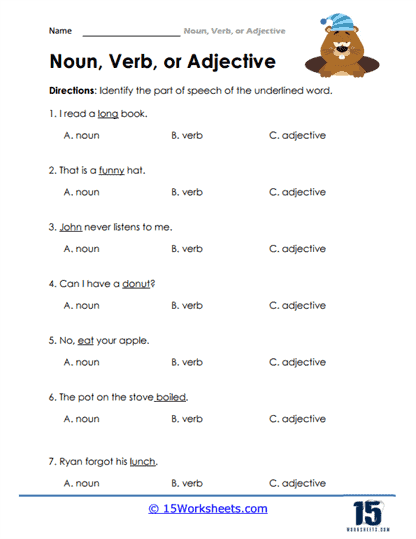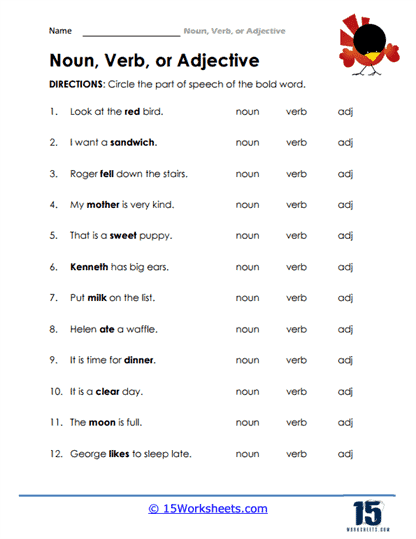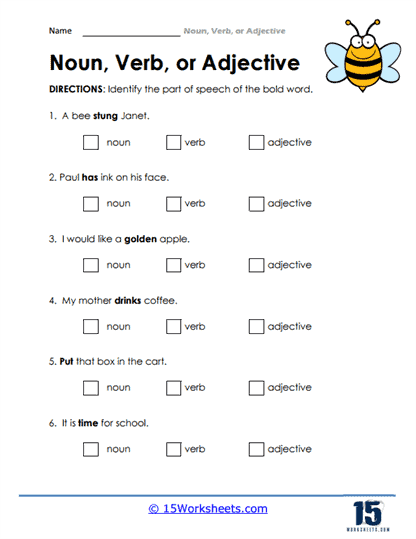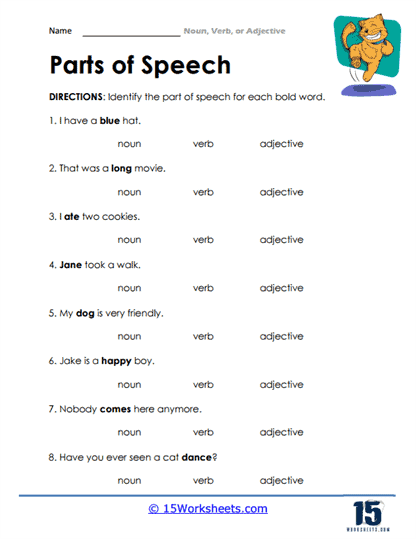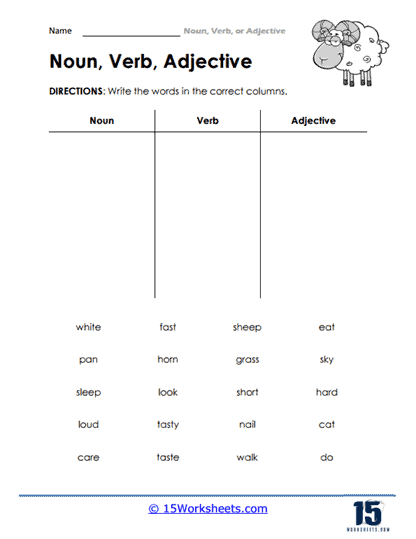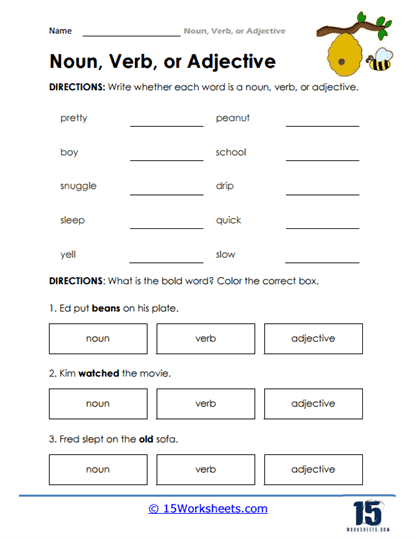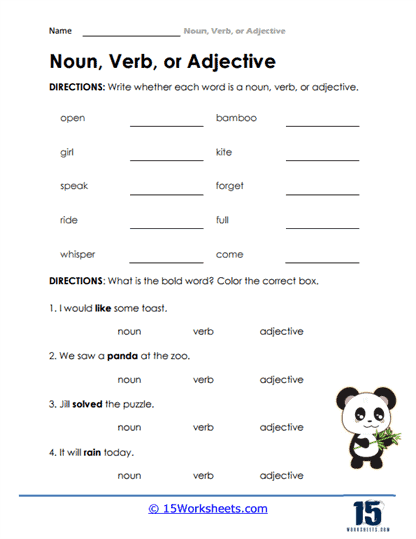Noun, Verb, or Adjective Worksheets
All About These 15 Worksheets
This collection of worksheets will help students master the foundational components of English grammar. These worksheets aim to clarify the differences between three essential parts of speech-nouns, verbs, and adjectives-while guiding students on how to use them correctly within the context of a sentence. The ability to distinguish between these parts of speech is crucial for effective communication, as it forms the bedrock of sentence structure, meaning, and clarity. By engaging with these worksheets, students develop both their grammatical understanding and practical language skills, which are vital for fluency in English.
At the core of these worksheets lies a series of thoughtfully designed exercises that introduce students to the process of identifying nouns, verbs, and adjectives. These tasks go beyond mere identification; they involve categorization, analysis, and contextual application of these words. The goal is to ensure that students not only recognize these parts of speech but also comprehend how they interact within a sentence. For instance, a noun may serve as the subject of a sentence, a verb as the action, and an adjective as the descriptor of a noun. Understanding these roles is key to constructing sentences that are not only grammatically correct but also meaningful and clear.
One of the most effective strategies employed by these worksheets is the categorization of words. In various exercises, students are presented with lists of words or sentences, and they are tasked with sorting these words into three distinct categories: nouns, verbs, and adjectives. This exercise reinforces the students’ knowledge of word functions, encouraging them to think critically about how words operate within the structure of a sentence. It is through this practice that students begin to see patterns in language and can confidently differentiate between a person, place, or thing (a noun), an action (a verb), and a word that describes (an adjective).
In addition to classification exercises, many worksheets include sentence-based activities. These exercises require students to identify the part of speech of certain underlined or bolded words in a given sentence. For example, in the sentence “The tall tree swayed gently in the wind,” students would be asked to determine that “tree” is a noun, “tall” is an adjective, and “swayed” is a verb. This process not only sharpens their ability to recognize parts of speech in context but also enhances their reading comprehension skills. As students learn to analyze the function of individual words, they simultaneously develop a deeper understanding of sentence structure and meaning. This dual benefit strengthens both their grammar and their ability to interpret written texts more effectively.
One of the most engaging aspects of these worksheets is the variety of activities they offer, which cater to different learning styles. For instance, visual learners may benefit from activities that incorporate coloring or matching games. In these exercises, students might be asked to color all the nouns in one color, verbs in another, and adjectives in a third. This interactive approach not only makes learning more enjoyable but also reinforces the student’s ability to identify parts of speech through a multi-sensory experience. By involving motor coordination alongside mental recognition, such activities create a deeper connection to the material.
For students who enjoy more hands-on learning, these worksheets might also incorporate matching exercises. In these, students match words with their respective categories-linking a noun, for example, to its definition as a “person, place, or thing” or pairing a verb with an action-based image. This kind of kinesthetic activity taps into the learner’s natural curiosity and desire for problem-solving, allowing them to actively engage with grammar concepts in a playful yet educational way. Through these methods, the worksheets become more than just a standard educational tool; they become an interactive experience that draws students into the learning process.
By utilizing a variety of worksheet formats-such as tables, fill-in-the-blank exercises, and sentence diagramming-these materials address multiple aspects of grammar comprehension. For students at different stages of their learning journey, this variety ensures that they are challenged appropriately. Beginners might work with simpler sentences and word lists, while more advanced learners might analyze complex sentence structures or explore how adjectives modify nouns in creative writing exercises. This differentiation in content allows teachers to tailor the worksheets to meet the needs of their students, ensuring that every student, regardless of their skill level, can benefit from these exercises.
Ultimately, these worksheets are designed to serve as a comprehensive resource for building a solid foundation in grammar. The exercises not only help students master the identification of nouns, verbs, and adjectives but also foster a deeper understanding of how these words function together to create cohesive, meaningful sentences. By repeatedly working through these worksheets, students gain confidence in their ability to construct grammatically sound sentences, which is a crucial skill for both writing and speaking in English.
What Are Nouns, Verbs, and Adjectives?
Nouns, verbs, and adjectives are the essential building blocks of the English language, forming the foundation upon which sentences are constructed. Each of these parts of speech plays a distinct and vital role in communication, allowing us to convey ideas, actions, and descriptions with clarity and precision. By understanding the unique function of nouns, verbs, and adjectives, we gain greater control over our language, enabling us to express ourselves more effectively in both writing and speech.
At the heart of any sentence lies the noun, which serves as the name of a person, place, thing, or abstract idea. Nouns are the “who” or “what” of a sentence. They provide the essential subjects or objects that give a sentence its core meaning. Without nouns, we wouldn’t know what we’re talking about or to whom we’re referring. Consider everyday words such as “book,” “teacher,” or “city.” These are common examples of nouns that help us to name objects or people around us. Beyond the tangible, nouns can also represent abstract ideas such as “happiness” or “freedom.” These intangible concepts are still pivotal in communication because they allow us to discuss emotions, beliefs, and philosophies. Nouns can stand alone as subjects or objects, or they can take on modifiers like articles (“a,” “the”) or adjectives to give more specific meanings. In the sentence “The teacher explained the lesson,” both “teacher” and “lesson” are nouns. The noun “teacher” serves as the subject, while “lesson” functions as the object of the action.
While nouns give us the subjects and objects of our sentences, verbs bring the sentence to life by expressing actions, occurrences, or states of being. Verbs answer the question of “what is happening” in the sentence, guiding the flow of information. Whether the subject is running, thinking, eating, or simply “being,” verbs are the dynamic force that propels communication. A verb like “run” clearly depicts physical action, while a verb like “is” might simply link a subject to its description or condition. For instance, in the sentence “She runs every morning,” the verb “runs” provides the action that gives the sentence its forward momentum. Alternatively, a state-of-being verb such as “is” or “was” helps to establish relationships between the subject and other components of the sentence, as in “He is happy” or “The book was interesting.” These verbs, though they may seem less active, are equally important for constructing sentences that describe conditions or situations rather than actions.
Whereas nouns and verbs form the structural framework of a sentence, adjectives add color and detail. They enrich language by modifying nouns or pronouns, offering deeper insight into qualities, quantities, and characteristics. Adjectives answer questions like “What kind?” or “How many?” For instance, in the sentence “The big, blue ball rolled down the hill,” the adjectives “big” and “blue” provide specific details about the ball, helping the listener or reader to imagine it more clearly. Adjectives not only enhance the visual or sensory qualities of a noun but also add layers of meaning. Words like “happy,” “frightening,” or “delicious” can alter the tone of a sentence and shape the reader’s or listener’s emotional response. They provide a spectrum of meaning, transforming a simple noun into something vivid, descriptive, and specific.
The beauty of language lies in the interplay between these three parts of speech. Nouns, verbs, and adjectives work together to create sentences that are both informative and expressive. For example, consider the sentence: “The clever fox swiftly jumped over the tall fence.” Here, we see all three parts of speech at play. The nouns “fox” and “fence” establish the key subjects and objects. The verb “jumped” conveys the action. And the adjectives “clever,” “swiftly,” and “tall” provide important details about the subject, action, and object, giving the reader a much clearer image of the scene. Without any one of these parts of speech, the sentence would feel incomplete or vague.
Understanding the differences between nouns, verbs, and adjectives not only helps us use them correctly but also encourages us to develop a more nuanced and creative use of language. For instance, in writing or speaking, selecting the right adjectives can turn a basic statement into a compelling description. Choosing specific nouns can clarify our subject matter, while using dynamic verbs can inject energy and movement into our expressions. Mastering the art of combining these parts of speech is the key to effective communication.
Worksheets and activities that focus on distinguishing between these parts of speech are a crucial element in language learning, especially for students developing their grammar skills. By practicing how to identify and use nouns, verbs, and adjectives correctly, students gain a better understanding of sentence structure, which is foundational to both speaking and writing. These worksheets often include exercises that require students to fill in blanks with the correct parts of speech or sort words into categories, reinforcing their knowledge. Importantly, such exercises often introduce new vocabulary, enabling students to expand their word bank while learning grammatical concepts. For example, a worksheet might present a series of sentences like “The ___ dog barked loudly,” prompting students to fill in the blank with an appropriate adjective. This not only reinforces the grammatical concept but also encourages creative thinking as students explore different ways to describe the dog.
Through consistent practice with these tools, learners become more adept at identifying and using nouns, verbs, and adjectives. This increased grammatical awareness contributes to improved communication skills, both in writing and conversation. When students can readily distinguish between these parts of speech, they can write with greater precision and clarity, crafting sentences that accurately convey their intended meaning. Additionally, by expanding their vocabulary with more nouns, verbs, and adjectives, students can engage in richer, more expressive communication.

